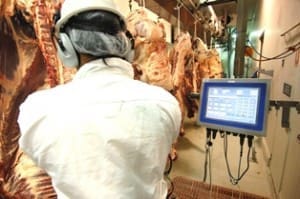DIRECT consignment slaughter grids in Queensland have typically surged another 10c/kg this week, as the sourcing challenge facing beef processors accentuates further after three years of drought impact.
Grids for slaughter in the southeast Queensland region – the largest concentration of processing capacity in the country – have lifted to 510c/kg for the typical four-tooth grassfed heavy steer, and 465c/kg on the heavy boner cow.
 Those prices have now risen 15c/kg in three weeks, which has helped deliver an ‘adequate’ flow of slaughter cattle, for the time being at least. Most Queensland processors remain fairly current in their forward bookings, however, with plenty of kill slots still available for early June.
Those prices have now risen 15c/kg in three weeks, which has helped deliver an ‘adequate’ flow of slaughter cattle, for the time being at least. Most Queensland processors remain fairly current in their forward bookings, however, with plenty of kill slots still available for early June.
Further north, Central Queensland grids appear about 10pc behind those rates, while just across the border, we’ve seen current grids for northern NSW kills week commencing 30 May at 500c/kg for four-tooth steer and 465c/kg the heavy cow. Victorian/southern NSW, grids are perhaps 20-30c better off than SEQ this week, as the seasonal flow of southern cattle rapidly declines. Weather forecast for Victoria in the next eight days could also further impact southern supply.
The question for processors now is, ‘Where to from here?’
Higher cattle price is realistically not going to create any more cattle, in the drought-impacted cattle supply pool that currently exists.
“You can only kill them once,” was the comment offered by a regular processor contact this week.
“Nobody is likely to do any more cattle than what’s currently being killed, and it’s unlikely that Eastern Australia will maintain anywhere near current rates of kills for long,” he said.
“There’s no oats-finished cattle coming forward in numbers this year, so come July, I’d expect we’d see another 10 percent shaved-off current slaughter volume, knowing what’s happened to herd numbers,” he said.
Any flow of finished grassfed cattle out of the Channel country this year is not likely til September or October, leaving a big lag period in the middle from mid-June through to September, when procurement this year could become a very big challenge.
That’s also the period when Queensland’s Central west typically kills a lot of its cattle, but drought destocking in that region in the past two years has been severe.
While there’s evidence of some additional cattle going onto feedlot programs now – in anticipation of pronounced tightness in supply and consequent higher prices in three months’ time – that’s not going to compensate in any significant way for overall starvation in slaughter supply, heading into the back-half of the year.
With processor trading desks saying there has been little appreciable change in export meat market outlook over the past couple of weeks, the only highlight on the ledger at present is the gradual deterioration in the value of the A$ again.
As Beef Central’s home-page graph shows, the A$ has now fallen close to US6c in the past four weeks, from an alarming US78c on April 21 to just above US72c this morning. That’s starting to be reflected in processor margins, even though export demand remains quite flat.
Thin margins for MSA, EU
Worth noting at this time is the relatively narrow price spread between commodity cattle and the premium MSA and EU types at present.
The MSA grassfed steer premium in Queensland and northern NSW currently is only 10-15c, with some offers this week seen at 525c/kg for 0-2 tooth MSA steer (Index 52-61). Better types are making closer to 535c on some grids.
Part of the explanation for that narrowing in MSA cattle premium is events in the domestic wholesale meat market. It’s not hard to find good 100-day grainfed rumps on the domestic market at present, apparently diverted (or more accurately, dumped) from a flat export trade, being sold whole in the vac bag at $10-$11/kg at retail.
Prices like that, for what’s still a pretty good product by domestic market standards, make it hard to defend a $2-$3 higher MSA wholesale/retail price, while ever products like that are available in quantity to consumers.
In the case of the EU grassfed premium, the narrowing appears to be related mostly to the fact that current kills are being tallied against the new EU quota shipment year, taking some of the quota defence impact out of the play that was evident only a month or two ago.
General decline in kills
There was a general decline in processing activity recorded by NLRS across all five Eastern Australian states last week.
Queensland’s kill fell 2pc to 75,088 head last week, back 18pc year-on-year. Female slaughter sank to below 30,000 head, less than 40pc of the state’s overall tally.
In NSW, last week’s tally of less than 34,000 head was back 5pc on the previous week, and -18pc on last year, while in Victoria, the kill of 26,300 was 15pc behind the same week in 2015.
South Australia’s kill at 7911 head lifted 1pc on the previous week, while Tasmania was unchanged at 4700 head.
We stand by our claim made in last week’s kill report that we may now have already seen the high water mark for Eastern States kills for the year, with the 151,000 head figure reported for the week ending 13 May now looking increasingly unlikely to be exceeded.



HAVE YOUR SAY